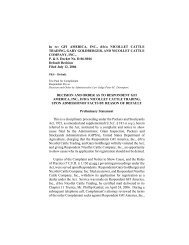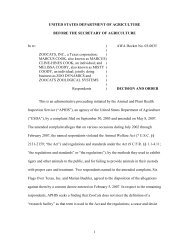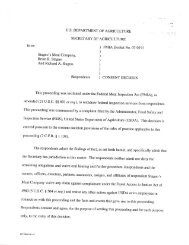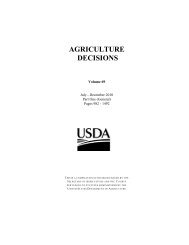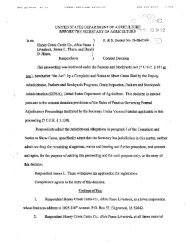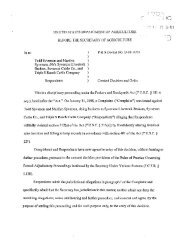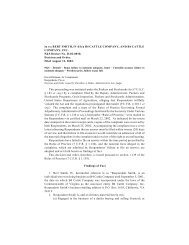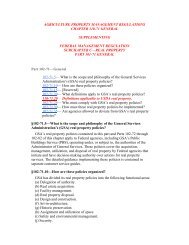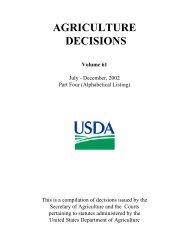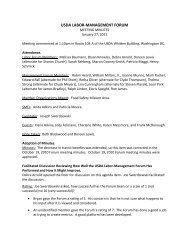Green Information Technology Strategic Plan - Departmental ...
Green Information Technology Strategic Plan - Departmental ...
Green Information Technology Strategic Plan - Departmental ...
You also want an ePaper? Increase the reach of your titles
YUMPU automatically turns print PDFs into web optimized ePapers that Google loves.
64<br />
Consolidation of all USDA applications and hardware infrastructure to EDCs will<br />
directly impact most of the Secretary’s <strong>Green</strong> program areas.<br />
outsource information processing requirements to other<br />
Federal or commercial data centers if the aggregate installed<br />
base is below minimum target sizes 39 .<br />
Many of the USDA locations that house application, server,<br />
storage, and related network infrastructure were not built<br />
to handle the requirements of such highly sophisticated IT<br />
equipment. Not only are these locations highly inefficient<br />
in electricity consumption for powering and cooling IT<br />
equipment, but they are also not properly equipped to<br />
handle the ongoing increase in needed wattage to power the<br />
IT equipment. As the amount of data being communicated<br />
across computing devices grows, USDA has been filling<br />
data center racks with increasingly powerful servers to keep<br />
pace. In Washington DC, the data centers and network<br />
closets that house such equipment are in buildings that were<br />
constructed circa 1930. It would take major structural,<br />
electrical, and network renovations to even approach<br />
current data center efficiency standards. Continuing to keep<br />
information technology and communication equipment<br />
scattered in these historic buildings not only keeps USDA’s<br />
power consumption needlessly high, but also inflates USDA’s<br />
business risk as energy shortages and power outages increase.<br />
The network communications of the United States supports<br />
putting information technology in the most efficient data<br />
center locations and transporting information to teleworkers<br />
or other employee business locations.<br />
To illustrate, Gartner research suggests that legacy data<br />
centers typically were built to a design specification of about<br />
35 to 70 watts per square foot. “Current design needs can<br />
vary from between 150 to 200 watts per square foot, and<br />
by 2011, this could rise to more than 300 watts per square<br />
foot. These figures for energy per square foot represent just<br />
the energy needed to power the IT equipment; they do not<br />
include the energy needed by air-conditioning systems to<br />
remove the heat generated by this equipment. Depending<br />
on the tier level and future equipment density plans in the<br />
data center, these cooling needs can increase the overall<br />
power requirements by an additional 80% to 120%.” 40<br />
The USDA has Enterprise Data Centers (EDC) that<br />
were specifically designed and constructed to take into<br />
consideration modern energy and cooling needs, operational<br />
processes, and efficiency standards. In order to take full<br />
advantage of USDA EDCs, all scattered server, storage, and<br />
related IT equipment should be taken out of highly inefficient<br />
data centers and net closets and physically consolidated to<br />
EDCs. Consolidation of all of USDA’s applications and<br />
hardware infrastructure to EDCs will directly impact most<br />
of the Secretary’s <strong>Green</strong> Program Areas, as well as drive<br />
USDA toward meeting the environmental goals set by E.O.<br />
13423 for Strengthening Federal Environmental, Energy,<br />
and Transportation Management 41 . Moving from highly<br />
fragmented, and often unnecessarily expensive, IT operations<br />
to a more-consolidated organization at the enterprise level<br />
has the potential to save a great deal of money, improve the<br />
capability of IT, and help minimize security and business<br />
continuity risks 42 .<br />
Current measurement:<br />
—Hardware and Infrastructure<br />
Currently the USDA has 30 data centers and 120 major<br />
network closets, consisting of an estimated 16,000 servers<br />
(figure includes Mainframe, Wintel, Unix, and other<br />
midrange servers). Most of these data centers and net closets<br />
do not meet EPA standards for energy efficiency, and will<br />
not be able to meet the goal of reducing energy intensity<br />
by 3% annually through the end of FY2015 as set by E.O.<br />
13423.<br />
—Energy Consumption<br />
Most large enterprise IT organizations spend approximately<br />
5% of their total IT budgets on energy alone. Some estimates<br />
go as high as 10% to 15%. Data centers account for a large<br />
portion of this energy consumption. This is especially true<br />
when an organization is using legacy data centers that do<br />
not meet modern standards for data center efficiency. If a<br />
data center is not efficient in consuming power, the energy<br />
costs can increase at a steep rate. The <strong>Green</strong> Grid Data<br />
Center Power Efficiency Metrics gauge a data center’s power<br />
consumption efficiency via Power Usage Effectiveness (PUE)<br />
ratio. Preliminary work indicates that many data centers<br />
have a PUE of 3.0 or greater 43 . If a data center has a PUE of<br />
3.0, it indicates that the IT equipment consumes 33% of the<br />
power in the data center. The closer a data center gets to 1.0,<br />
the closer the data center comes to 100% efficiency.<br />
<strong>Green</strong> <strong>Information</strong> <strong>Technology</strong> <strong>Strategic</strong> <strong>Plan</strong>




